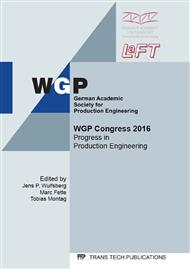[1]
P. Larour, Strain rate sensitivity of automotive sheet steels: influence of plastic strain, strain rate, temperature, microstructure, bake hardening and pre-strain, Shaker, Aachen, (2010).
DOI: 10.1002/srin.201200099
Google Scholar
[2]
D. Jocham, R. Norz, W. Volk, Strain rate sensitivity of DC06 for high strains under biaxial stress in hydraulic bulge test and under uniaxial stress in tensile test, International Journal of Material Forming (2016), pp.1-9.
DOI: 10.1007/s12289-016-1293-8
Google Scholar
[3]
S. Suttner, M. Merklein, Experimental Investigation of the Biaxial Stress State in the Biaxial Tension Test for the Identification of Constitutive Models for the Finite Element Simulation, Tagungsband Werkstoffprüfung (2013), pp.59-64.
Google Scholar
[4]
A. Rusinek, J.R. Klepaczko, Shear testing of a sheet steel at wide range of strain rates and a constitutive relation with strain-rate and temperature dependence of the flow stress, International Journal of Plasticity (2001), pp.87-115.
DOI: 10.1016/s0749-6419(00)00020-6
Google Scholar
[5]
A. E. Tekkaya, K. Pöhlandt, K. Lange, Determining Stress‐Strain Curves of Sheet Metal in the Plane Torsion Test. CIRP Annals – Manufacturing Technology, 40 (1982), p.171‐174.
DOI: 10.1016/s0007-8506(07)63291-0
Google Scholar
[6]
R.C. Picu, A mechanism for the negative strain-rate sensitivity of dilute solid solutions, Acta Materialia 52 (2004), p.3447–3458.
DOI: 10.1016/j.actamat.2004.03.042
Google Scholar
[7]
C.S. Seok, K.L. Murty, Effect of dynamic strain aging on mechanical and fracture properties of A516Gr70 steel, International Journal of Pressure Vessels and Piping 76 (1999), pp.945-953.
DOI: 10.1016/s0308-0161(99)00075-7
Google Scholar
[8]
J.E. Hockett, O.D. Sherby, Large strain deformation of polycrystalline metals at low homologous temperatures, J. Mech. Phys. Solids 23 (1975), pp.87-98.
DOI: 10.1016/0022-5096(75)90018-6
Google Scholar
[9]
F. Ostermann, Aluminium Technologie-Service, Springer, Berlin, (2014).
Google Scholar
[10]
M. Merklein, M. Johannes, M. Biasutti and M. Lechner, Numerical optimisation of a shear specimen geometry, Key Engineering Materials 549 (2013), pp.317-324.
DOI: 10.4028/www.scientific.net/kem.549.317
Google Scholar
[11]
H.F. Norton, The creep of steel at high temperatures, MacGaw-Hill, New York, (1929).
Google Scholar
[12]
N.J. Hoff, Approximate analysis of structures in the presence of moderately large creep deformations, Quart. Appl. Math. 12 (1954), pp.49-55.
DOI: 10.1090/qam/61004
Google Scholar
[13]
T. Tsuda, S. Tanimura, A. Abe, M. Katayama,T. Sakakibara, Implementation of the Tanimura-Mimura's Strtain rate Dependend Constitutive Model in LS-DYNA Using User Defined Material Model, 11th International LS-DYNA Users Conference Automotive (1) (2010).
Google Scholar
[14]
R.C. Picu, G. Vincze, F. Ozturk, J. Gracio, F. Barlat and A. Maniatty, Strain rate sensitivity of the commercial aluminum alloy AA5182-O, Materials Science and Engineering A 390 (2005), pp.334-343.
DOI: 10.1016/j.msea.2004.08.029
Google Scholar
[15]
R. von Mises, Mechanik der festen Körper im plastisch-deformablen Zustand, Nachrichten von der Gesellschaft der Wissenschaften zu Göttingen, Mathematisch-Physikalische Klasse (1918), pp.582-592.
DOI: 10.1007/978-3-662-25046-4_2
Google Scholar
[16]
K.G. Hoge, Influence of Strain Rate on Mechanical Properties of 6061-T6 Aluminum under Uniaxial and Biaxial States of Stress, Experimental Mechanics 6 (1966), pp.204-211.
DOI: 10.1007/bf02326150
Google Scholar
[17]
J.E. Dorn, Stress-Strain Rate Relations for Anisotropic Plastic Flow, Journal of Applied Physics 20 (1949), pp.15-20.
DOI: 10.1063/1.1698231
Google Scholar


